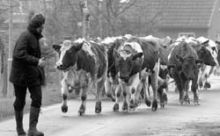A cow died of anthrax last Tuesday on a private farm belonging to a Niva agricultural company worker in the village of Berezivka, Vinnytsia oblast, Forum (www. for-ua.com) reports. The Ministry for Emergency Management has imposed a quarantine in the village and begun to carry out anti-epizootic actions. Persons who have been in contact with afflicted animal have been put under medical observation.
Of course, against the backdrop of a panic-stricken Europe, Ukraine looks like a beef oasis even after this kind of information. However, on the other hand, we have a lot of animal diseases of our own, and, on the other, the meat packing industry could slide into its own crisis. Thus, even if veal does not become a risky comestible, it could cost a pretty penny for many of our compatriots. In principle, Kyiv supermarket and kiosk shelves are already displaying a wide range of soy meat substitutes.
As our cows have not yet been integrated in Europe by being fed with meat and bone flour containing prion, the low-molecular protein that actually causes the disease, no instances of mad cow disease have so far been recorded on the territory of Ukraine, Oleksandr Kucheriavenko, Ukraine’s deputy chief state inspector of veterinary medicine, told The Day on April 4. However, Ukraine has the so-called risk group of 15-17,000 head of cattle imported from Europe, now under continuous veterinary oversight. Ukraine is now taking all the necessary precautions: it has banned the import of cattle and meat products from risk countries, including the import of meat items carried in hand luggage, and all customs posts plan to safety- treat the footwear of those arriving from Europe. Mr. Kucheriavenko also said that Ukraine has all the necessary vaccines and related equipment to vaccinate animals in a short time and set up a buffer zone in western Ukraine, for it is Europe from which the potential danger can come.
Vitaly Mareniuk, chief of the department of extremely hazardous infections at the central public- hygiene and epidemics station of the Ministry of Public Health of Ukraine, also told The Day that all units at public-hygiene stations have now been alerted and are taking measures to minimize the likelihood of the outbreak of the foot-and-mouth disease and false mad cow disease among people.
The scourge of our animal husbandry, according to Mr. Kucheriavenko, is leucosis, but it is being constantly addressed and not without success: the animal population is examined and, if necessary, treated twice a year, with the infected animals either isolated or destroyed. As a result, eight oblasts are completely free of leucosis. The veterinary service is constantly watching livestock, especially those to be slaughtered and have their meat sold. Given continuous analyses, examinations, and research, it is practically impossible for the affected meat to make its way to city markets. Makeshift market places is a different thing. As the deputy chief veterinary medicine inspector pointed out, people who buy meat there run a high risk because in most cases this meat is of unknown quality and origin.
Yet, foot-and-mouth disease is now the most dangerous animal ailment in Ukraine. This disease is transferred very fast and can embrace a large territory in a short time. This happened in the USSR in 1965-1969, when practically our whole territory was infected with the disease. The situation is further aggravated by the fact that Ukraine has not vaccinated its cattle against foot-and-mouth since 1992: under international regulations, a country that does not vaccinate its cattle is considered epizootically unsafe and could call down upon itself economic sanctions.
However, it is difficult in principle to frighten Ukraine with sanctions. Yuri Melnyk, director of animal product markets at the Ministry for Agrarian Policies, announced that the difficult epizootic situation in Europe will not lead to a significant increase in animal product exports from Ukraine. He also added, reports Interfax-Ukraine, that Ukraine will find it more advantageous to sell live cattle on the domestic market than to export it. “One kilogram of live cattle weight sells at 5.2-5.25 hryvnias, plus a 77-89 kopeck surcharge as subsidy for 1 kg of heavy-weight live cattle. In other words, 1 kg will cost $1, while, exporting live cattle, the commodity producer will receive $0.90 per kilo.” Noting that last year Ukraine increased the export of large horned cattle from 3,000 (1999) to 16,000 head, the director of animal product markets at the Ministry of Agrarian Policies said, “These are small quantities for Ukraine... Today’s forecast is that if the domestic market keeps up this price, there will be no increase in large horned cattle exports.” Mr. Melnyk thinks Ukraine will also see no increase in the export of animal products because of the need to first meet domestic market demand.
(See also page Economy/Business)







